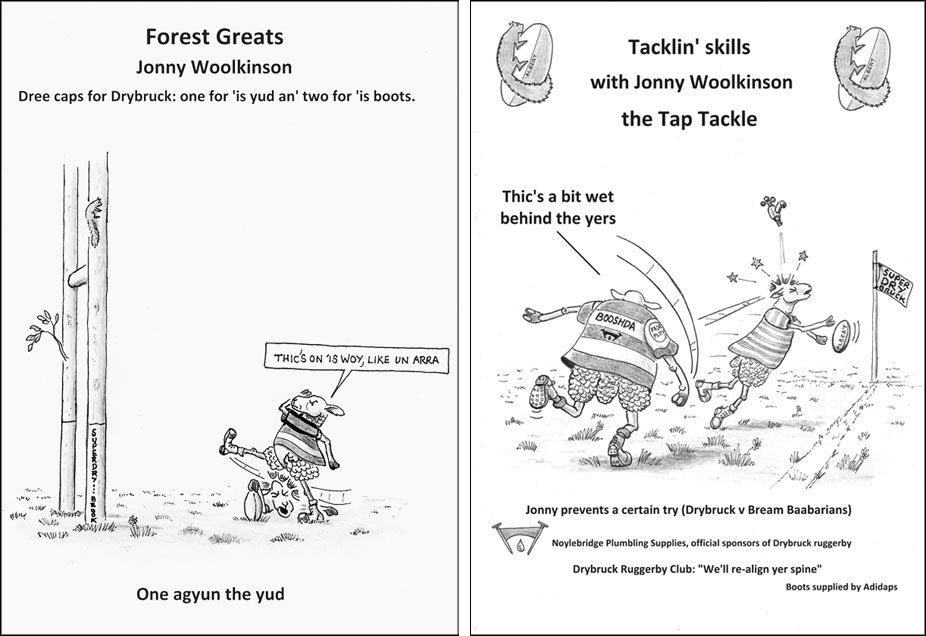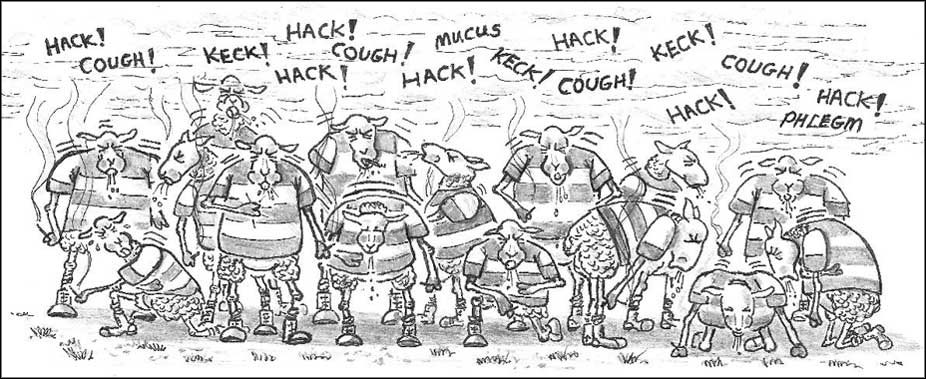Recently discovered evidence throws new light on origins of the game
Spotlight on Drybruck Ruggerby Club
Club anthem: “You’ll never walk agyun”
By
His Majesty, Topham Hogg IV
It is thought that the origins of the modern game lie in the valley between Wigpool and Ruardean, centred on Drybrook tump (circa 1400 AD). At that time the game had few rules and, as illustrated by a recently discovered cave painting in Wigpool iron mine, was extremely violent; when a spear tackle – a dangerous tackle outlawed by the RFU – really did involve a pointed weapon. It’s worth noting that Rogere de Ayle, a wood and nail merchant, is said to have started his long and illustrious playing career at Drybruck, when the game was at its most dangerous. He played well into the 15th century, clocking up over 3000 appearances. He also campaigned tirelessly to have spears
banned from all on-field action – Drybruck was losing too many players through blood injuries.
The ancient Book-a-Denzil refers to a rough and tumble game called “Thugby”.
Denzil states: “Aroun’ the viffteenth century, boy-chaps wi’ stubbly chins an’ coal-blackund vaces gathered in the vield ov Mannins t’vight among the tuffutts wi’ a baul ov curiouss shoype. Boy-chaps vrom Drybruck, Marse layne an’ Noylebridge wuz the most cruel in the districk, an’ so wuz made fer the “Thugby”. Made ov a dyud cowse udder villed wi’ straw, conkers, an’ cobbawz, an’ baked in a vurniss fer a shart time, the baul wuz coverd wi’ squirrauws vur, sewed t’gether by the wimmin ov Puddaubruck. When flung abowt an’ kicked abowt, the baul ‘ad unpredictabubble tenduncies an’ did bounce abowt like a kyat gone mentull wi’ musturd smeared on ‘is furry ring. Thirty boy-chaps, an’ a feow spares in case
ov injuree, did take t’zides ov viffteen an’ vight on’t out t’get the baul to t’other end ov the “pitch” an’ score a “trigh”.
Ahder that, a boy-chap wi’ a zweet right peg on in did ‘oof the baul over the zdicks fer a konvershun. Much vylunce wuz dyshed out in the goyme, speshlee in a “skrum”, “mawl” an’ a “rucc”, when many tith an’ eyes wuz vetched out, an’ many bollix crushed. An’ crowdz did gather wi’ a gutsvulla tanglevut an’ shout, “Drive a bugger in toon”, “Vetch the znot out on in” an’ “Kick’n in the tempau, is feyther wuz vrom Stemmill an’ gid me zister a babby. Ugli bugger an’ all, a wuz”. Ahder the battaw, they wuz all mates agyun an’ feasted in the glub’ouse on sossigiz an’ mash, weshed down wi’ a zginvulla jal. An’ ahder that, much oomanizin’ an’ lude anticks comed t’pass, wi’ even more vightin’ t’zettle old scores

The Hack-up
Before a game commences, all modern-day Drybruck Ruggerby teams confront their non-smoking opponents with a war dance that serves to intimidate them; to let them know “they be in var’t”. Called “The Hack-up”, this ritual has been revived by Drybruck and is practised by no other Forest Ruggerby club.
The Hack-up involves the team smoking roll-ups to excess, starting a full hour before kick-off, thus inducing fits of coughing, kecking and finally hacking to clear the airways of mucus, phlegm and snot. Few opposition teams fail to be impressed, and show their appreciation by laughing hysterically – a mark of respect, indeed.
The Hack-up is derived from a more obscure war dance, and one whose roots are lost to history: the Bacca – for which players smoked pieces of dried “Honesty”, a wild clematis (Clematis Vitalba) commonly known as Old Man’s Beard, Traveller’s Joy, Boy’s Bacca or Smoke Wood.


